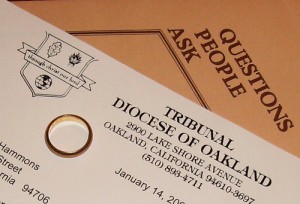 When I open the envelope containing a notice from the Diocese of Oakland that my EX of several years has petitioned for a Declaration of Invalidity, my first reaction is to laugh and toss the paperwork into the recycling bin. But the words toll like solemn bells throughout the day. Ecclesitasticum, Ajudication, Decree of Constitution. In the grip of the language as I had been some twenty years ago when I made the mistake of converting to Catholicism, I retrieve the paperwork. Over the past few years as I filed restraining orders and argued over custody arrangements, I regularly received mail from Family Court Services, the County of Alameda and various lawyers. I had yet to be summoned by a Tribunal.
When I open the envelope containing a notice from the Diocese of Oakland that my EX of several years has petitioned for a Declaration of Invalidity, my first reaction is to laugh and toss the paperwork into the recycling bin. But the words toll like solemn bells throughout the day. Ecclesitasticum, Ajudication, Decree of Constitution. In the grip of the language as I had been some twenty years ago when I made the mistake of converting to Catholicism, I retrieve the paperwork. Over the past few years as I filed restraining orders and argued over custody arrangements, I regularly received mail from Family Court Services, the County of Alameda and various lawyers. I had yet to be summoned by a Tribunal.
Hoping to hear from you in the near future. The Reverend Presiding Judge signs the cover letter as if we were buddies at camp separating for the school year. He reminds me to include my Case Number on all Tribunal correspondence, including the enclosed Respondent Citation Form.
I am divorced. Happily so. Divorce ends marriage. Annulment invalidates it. Because my children and I have spent a considerable amount of time in therapy learning to cope with the reality that was our lives when I was married to their father, I decide to contest the annulment. I object to the fact that the Catholic Church provides EX with what even drugs and alcohol have not: a way to invalidate reality.
I am encouraged to respond in one of two expeditious manners: mail-in questionnaire or phone interview. But I don’t live that far from the Diocese of Oakland, so I request a personal interview. While I wait for it to be scheduled, I envision scenes from Umberto Eco’s “The Name of the Rose”. Priests in long robes scuttle along a honeycomb of secret passages. Acolytes scent dark musty rooms with censers full of incense.
Beth, who calls to schedule the interview, tells me that she will use the same questions that are on the mail-in form. Though I am disappointed that the interview will not be conducted by the Officialis or Judicial Vicar, I make the appointment and scribble down the punch-in code that unlocks the automated gate to the Diocese parking lot.
The Diocese is located in an unattractive brick building, easily mistaken for an office park, on Lake Shore Avenue in downtown Oakland, just blocks from the Alameda County Courthouse. The only priest I see during my visit is the one who rushes out into the parking lot protecting his head with a newspaper as rain begins to fall. He drives away in his Volvo, leaving the gate open. I don’t even get to use the code I possess.
Inside, the Diocese operates like a gentle-security prison. Women encased in glass booths control the intercoms, buzzers, locks and low metal gates that swing open automatically once those seeking admittance are granted entry. In the designated waiting area I take a seat and pick up the Diocese newsletter from a nearby table. On the cover, the Bishop of Oakland and several women—victims of sexual abuse by priests—fling their arms wide in joyous conciliatory rapture. Where are all the little boys? It occurs to me that the security might be to protect the Diocese from angry victims and their families. I lean over the little metal gate and tap on the glass window of the nearest control booth.
“Yes?” An elderly woman clicks on the speaker so that her voice is magnified out into the lobby.
“I had a question about all the security. Has it always been like this or just since the abuse cases?”
The speaker fills with static as she puts her hand over it. She turns off the intercom, and almost immediately Beth comes to fetch me. She looks like the most recent incarnation of Betty Crocker, neatly coifed hair, just a hint of lipstick on her benevolent smile, smart and savvy. Ready to serve. We shake hands and exchange pleasantries. She notes the time and comments that she has to pick her children up from school in an hour, letting me know this won’t take long. She directs me down the sterile corridor and into a bare cubicle with a door that slides shut for privacy. I am somewhat claustrophobic and ask if she would mind leaving the door open.
“It’s for your protection,” she says gently, closing it. “We want to ensure your privacy.”
I’m already sweating. Air begins to blow through a small vent in the ceiling. Its presence is detected by the cashmere fibers of Beth’s pale blue turtleneck. They bristle like tiny whiskers as we begin.
Beth takes a bright yellow legal tablet and a pen from a surprisingly fat folder that I soon discover contains a partial history of my relatively brief life as a Catholic. Glancing at some notes clipped to the inside, she says, “I see that your ex-husband also had your first marriage to him annulled.”
“That’s right. We were married briefly once before.”
“And you didn’t contest that annulment?”
I tell her that I only vaguely remember it, a phone call from EX informing me of the proceeding. “We had been married by a Justice of the Peace. I was the one who filed for divorce. It was 25 years ago. The details are fuzzy.“
“But then you married him again, three years later?”
“Yes. Or maybe not. If you don’t consider what we were doing from 1981 to 1997 a marriage.”
Beth sighs. “You are providing testimony that will be sent to the Tribunal of the First Instance. Then the Defender of the Bond will be called in to hear the case. If it is decided in the Affirmative, it will be sent to the Tribunal of the Second Instance where a final decision will be rendered.”
“That’s quite a line-up.”
“Annulments are not granted easily,” Beth assures me. “Did you read the information we sent you? We don’t blame. It could be that neither of you had the capacity to assume marital obligations.”
“So a double-fault annulment is kind of like the no-fault divorce?”
Beth is not here to joke around. “Why don’t you tell me why you entered into marriage with your ex-husband the second time.”
“I loved him. I loved him the first time, too, but we were very young. He made it really hard for me to do things I wanted to do.”
“Like what?” Beth asks.
“Go to school, write, have friends. He drank a lot. Couldn’t keep a job. I had two.”
“And this changed?”
“After the divorce—the first one—I went to grad school. Got a teaching job at UC Berkeley. His songwriting career was taking off and he’d held the same job for several years. We still wanted a lot of the same things.”
“Such as?”
“A way of life that would allow us to write and travel, which we did for several years until we had children.”
Beth is quiet as she finishes writing a long passage and quickly flips to a blank page. “He had quit drinking?”
“No. We both partied a lot,” I confess. “All of that ended for me when we had children.”
“You remarried knowing that he was an alcoholic?”
“Would that make me incapable of fulfilling my marital obligations?”
Beth ignores me. She is the inquisitor here. “What steps did you take to ensure that your second marriage would be more successful than the first?”
“We took those Catholic marriage classes.”
“Pre-Cana is required.” Beth says.
“I’m not looking for extra credit.” My little joke is met with silence. “But Father Henley, the priest who conducted the Pre-Cana, was the same priest who helped EX initiate the first annulment proceedings.”
Beth stops writing.
“I guess he thought we could fulfill our marital obligations, or he wouldn’t have performed the Sacrament of Marriage on us. Don’t you think that’s significant?”
Beth scoots back in her chair. “I don’t decide what’s important.”
“But you do. You write some things down and not others,” I protest. “I don’t understand how the Catholic Church can even take this request for an annulment seriously. Fifteen years. Two children. We went through all the Catholic rigmarole.”
Beth pulls at the collar of her turtleneck. “Did you seek counseling while you were married?”
“We did, but the therapist said she couldn’t help us.”
Beth’s neatly shaped eyebrows arch.
“She said that until EX faced his alcoholism, therapy would be of no use. Privately, to me, she suggested an intervention.”
“Did you try that?”
“None of the rehabs on my insurance had space. I couldn’t find a friend or family member to rush him off to rehab the minute he saw the light. His doctor told me he had never treated anyone so committed to his alcoholism as EX was. And, frankly, I was overwhelmed. I had two little kids, one of them a diabetic.”
“Special needs children can be very challenging to a marriage.” Beth starts scribbling again.
“Is that what you are writing down?” I find it unfair that my youngest son is cited as a problem when contradictory Catholic practice is not.
Beth bristles. “When we finish, you can read over my notes and add your comments. Later you can request a copy of the transcript.”
I realize that in contesting the annulment, I am, in the eyes of the Catholic Church, providing grounds for it. “It was a mistake for me to come here.” I rise to leave, angry with Beth because she will not collude with me in something I have no right to expect from a devout Catholic woman providing lay service to her Church: confirmation that annulment is an empty exercise, a meaningless, medieval ritual.
“Remember,” Beth says, “according to the laws of the Tribunal you are not free to divulge the details of this interview.”
“It’s the 21st century, Beth.” I say her name for the first time. “We live in the United States of America. I can divulge whatever I want.” I slide open the door and walk swiftly back down the sterile hallway, out the lobby and through the electronic gate where a different woman stands sentry.
***
Several weeks later, the Holy Tribunal renders its decision:
EX is cited by Catholic law c1095.3a: Incapacity to Assume Marital Obligations.
I am slapped with c1095.2: Grave Lack of Discretionary Judgment.
Double-fault annulment. Catholic divorce.
 Jane Hammons teaches writing at UC Berkeley. She has work included in Hint Fiction: An Anthology of Stories in 25 Words or Fewer (W. W. Norton 2010) and The Maternal is Political (Seal Press 2008). She recently received a Derringer Award from the Short Mystery Story Society. Her nonfiction has appeared in Columbia Journalism Review, The San Francisco Chronicle Magazine, and The East Bay Express. View her Fictionaut profile.
Jane Hammons teaches writing at UC Berkeley. She has work included in Hint Fiction: An Anthology of Stories in 25 Words or Fewer (W. W. Norton 2010) and The Maternal is Political (Seal Press 2008). She recently received a Derringer Award from the Short Mystery Story Society. Her nonfiction has appeared in Columbia Journalism Review, The San Francisco Chronicle Magazine, and The East Bay Express. View her Fictionaut profile.



Jane,
I loved this story! Having been raised and schooled as a Catholic, I can appreciate the “smoke and mirrors” thinking that seems to pervade much of the Church’s proceedings. I especially liked your use of detail to create the other women in this piece – you chose such significant, telling concrete images. Well crafted with scenes appropriately paced, beautiful voice of righteous anger tempered with a sensitive need for justice, and a lasting impact on the reader.
Mary, thanks so much for your thoughtful comments.
This story sounds like a mirror image of what happened to me, although my EX was incarcerated in prison and converted to Catholicism when he wanted to marry a Catholic woman. I think this has inspired me to write my story and its ending.
It sounds like a very interesting story! When I began writing this, I was inspired by someone who had once been married to a Kennedy (I forget which). They had several children who were practicing Catholics, as was she, and she contested the annulment (he wanted to remarry), lost, and wrote a book about it. I think these stories are important!
What an exquisite example of precision, Jane! I love this piece, and much of my awe comes from the restraint in your tone throughout. The bristling is there, but you let us feel it, rather than just hear it.
Thanks, Chelsea, for your comment about precision. It wasn’t always there, especially not in the version that is about 10 pages longer than this one. Learning to cut is a valuable writer’s tool!
This piece is stunning in its drama and details. I felt completely immersed in the story. Brava!
Thank you, Lisa.
This was very good. Read the whole way through and felt for the author. I am no marriage guru, so I do wonder how (aside from a technicality in symbolic significance) changing a divorce to an annulment has effected your life.
Thanks for your comment, Carol. Both the divorce and the annulment stand since one is a legal procedure (divorce) and the other is something only the Catholic church cares about. The most difficult thing about the annulment was explaining it to my children, who at the time were very involved with their religion via their father. They didn’t understand why the church wanted to say that essentially their parents had never been married. I had no answer, and really, neither does the church. But the annulment is essential for anyone married in the Catholic church who is divorced and wants to remarry in the church. It’s complicated . . . and ridiculous!
A wonderfully crafted piece, and about not at all what I thought it would be about from its title. Thanks for the bravery in sharing.
Thanks, for reading, Mayumi.
What an incredible insight into a ridiculous and sad situation, told so sharply I read it again to learn how to craft an essay both concise and rounded. A great example of refined prose.
Thanks, Suzanne! Believe me, this piece was revised a zillion times!